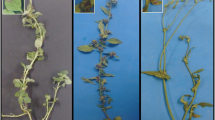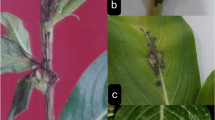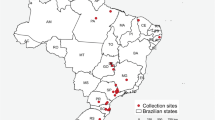Abstract
In order to verify the role of cruciferous weeds and ornamentals to serve as a source of primary inoculum of Xanthomonas campestris pv. campestris (Xcc), the causal agent of black rot of Brassicas, Xanthomonas isolates from shepherd’s purse (Capsella bursa-pastoris), fanweed (Thlaspi arvense) and wallflower (Erysimum cheiri) were characterized by molecular data and by their pathogenicity on kohlrabi and shepherd’s purse. These characteristics were compared to those of xanthomonads isolated from infested Brassica crops and contaminated transplants. Only one of 30 Xanthomonas isolates from shepherd’s purse in boundary ridges and field paths adjacent to Brassica fields, and from plants outside the Brassica growing area, was able to induce black rot (BR) on kohlrabi; nearly all of them (except one) were able to cause black rot like symptoms with black vascular veins (BRL) on shepherd’s purse. Six of ten tested isolates from different asymptomatic weeds growing in BR infested cauliflower fields were able to induce BR on kohlrabi, but all isolates caused BRL on shepherd’s purse. All Xanthomonas isolates from symptomatic wallflower induced BR on kohlrabi and BRL on shepherd’s purse. Inoculations with isolates from BR infested cauliflower, representing the pathovar campestris (Xcc), always led to BR on kohlrabi and BRL on shepherd’s purse. The isolates from rucola and radish field crops and from Brassica transplants showed typical symptoms of the pathovars campestris (Xcc) and raphani (Xcr), respectively. In a PCR with the newly designed primer set SP-1, only the isolates which were able to induce BR on kohlrabi could be detected. The sequence analysis of the gyrB-gene showed that all Xanthomonas isolates which induced BR on kohlrabi clustered in one major clade, while the remaining isolates clustered into several different clades. Based on these results, the authors conclude that Xanthomonas isolates from shepherd’s purse may not constitute a serious risk to serve as primary inoculum for BR epidemics in Brassicas. By contrast, Xanthomonas isolates from wallflower have this potential. Most of the isolates from cruciferous weeds and the wallflower isolates do not fit into the actual classification of Xanthomonas campestris pathovars.




Similar content being viewed by others
References
Anonymous. (2001). Crop Protection Compendium. Wallingford, UK: CAB International (CD-ROM).
Anonymous. (2017). Gemüseerhebung - Anbau und Ernte von Gemüse und Erdbeeren 2016. Statistisches Bundesamt (Destatis), Wiesbaden, Germany; Fachserie 3, Reihe 3.1.3. p. 8. https://www.destatis.de/DE/ZahlenFakten/Wirtschaftsbereiche/LandForstwirtschaftFischerei/ObstGemueseGartenbau/Tabellen/BetriebeAnbauErntemengeGemuese.html. Accessed 23 March 2017.
Berg, T., Tesoriero, L., & Hailstones, D. L. (2005). PCR-based detection of Xanthomonas campestris pathovars in brassica seed. Plant Pathology, 54, 416–427.
Chidamba, L., & Bezuidenhout, C. C. (2012). Characterization of Xanthomonas campestris pv. campestris isolates from South Africa using genomic DNA fingerprinting and pathogenicity tests. European Journal of Plant Pathology, 133, 811–818.
Clark, K., Karsch-Mizrachi, I., Lipman, D. J., Ostell, J., & Sayers, E. W. (2016). GenBank. Nucleic Acids Research, 44(D1), D67–D72.
Dane, F., & Shaw, J. J. (1996). Survival and persistence of bioluminescent Xanthomonas campestris pv. campestris on host and non-host plants in the field environment. Journal of Applied Bacteriology, 80, 73–80.
Fargier, E., & Manceau, C. (2007). Pathogenicity assays restrict the species Xanthomonas campestris into three pathovars and reveal nine races within X. campestris pv. campestris. Plant Pathology, 56, 805–818.
Fargier, E., Fischer-Le Saux, M., & Manceau, C. (2011). A multilocus sequence analysis of Xanthomonas campestris reveals a complex structure within crucifer-attacking pathovars of this species. Systematic and Applied Microbiology, 34, 156–165.
Hall, T. A. (1999). BioEdit: a user-friendly biological sequence alignment editor and analysis program for Windows 95/98/NT. Nucleic Acids Symposium Series, 41, 95–98.
Hanf, M. (1982). Ackerunkräuter Europas mit ihren Keimlingen und Samen. Stuttgart: Verlag Eugen Ulmer.
Hanzlik, K., & Gerowitt, B. (2012). Occurrence and distribution of important weed species in German winter oilseed rape fields. Journal of Plant Diseaes and Protection, 119, 107–120.
Ignatov, A., Sechler, A., Schuenzel, E. L., Agarkova, I. V., Oliver, B., Vidaver, A. M., & Schaad, N. W. (2007). Genetic diversity in populations of Xanthomonas campestris pv. campestris in cruciferous weeds in central coastal California. Phytopathology, 97, 803–812.
Krauthausen, H. J., Kreiselmaier, J., Laun, N., & Schlaghecken, J. (2006). Xanthomonas-Adernschwärze des Kohls. Gemüse, 42, 24–26.
Krauthausen, H.-J., Laun, N., & Wohanka, W. (2011). Methods to reduce the spread of the black rot pathogen, Xanthomonas campestris pv. campestris, in brassica transplants. Journal of Plant Diseases and Protection, 118, 7–16.
Parkinson, N., Aritua, V., Heeney, J., Cowie, C., Bew, J., & Stead, D. (2007). Phylogenetic analysis of Xanthomonas species by comparison of partial gyrase B gene sequences. International Journal of Systematic and Evolutionary Microbiology, 57, 2881–2887.
Popovic, T., Balaz, J., Ignjatov, M., Mitrovic, P., Gavrilovic, V., & Josic, D. (2014). Identification and genetic characterisation of Xanthomonas campestris pv. campestris as an oilseed rape pathogen in Serbia. Journal of Plant Pathology, 96, 553–560.
Rijlaarsdam, A., Woudt, B., Simons, G., Koenraadt, H., Oosterhof, J., Asma, M., Buddiger, P., Roorda, P., Grimault, V., De Koning, J. (2004). Development of specific primers for the molecular detection of Xanthomonas campestris pv. campestris. In EPPO Conference on quality of diagnosis and new diagnostic methods for plant pests. Noordwijkerhout, The Netherlands, 19–22 April 2004.
Roberts, S. J., Hiltunen, L. H., Hunter, P. J., & Brough, J. (1999). Transmission from seed to seedling and secondary spread of Xanthomonas campestris pv. campestris in brassica transplants: effects of dose and watering regime. European Journal of Plant Pathology, 105, 879–889.
Saitou, N., & Nei, M. (1987). The neighbor-joining method: a new method for reconstructing phylogenetic trees. Molecular Biology and Evolution, 4, 406–425.
Schaad, N. W., & Dianese, J. C. (1981). Cruciferous weeds as sources of inoculum of Xanthomonas campestris in black rot of crucifers. Phytopathology, 71, 1215–1220.
Schultz, T., & Gabrielson, R. L. (1986). Xanthomonas campestris pv. campestris in Western Washington Crucifer Seed Fields: Occurrence and Survival. Phytopathology, 76, 1306–1309.
Singh, D., Rathaur, P. S., & Vicente, J. G. (2016). Characterization, genetic diversity and distribution of Xanthomonas campestris pv. campestris races causing black rot disease in cruciferous crops of India. Plant Pathology, 65, 1411–1418.
Tamura, K., Peterson, D., Peterson, N., Stecher, G., Nei, M., & Kumar, S. (2011). MEGA5: molecular evolutionary genetics analysis using maximum likelihood, evolutionary distance, and maximum parsimony methods. Molecular Biology and Evolution, 28, 2731–2739.
Thines, M., Brändle, F. (inventors), IDENTXX GmbH (assignee). (2007). Organism-Specific Hybridisable Nucleic Acid Molecule. European Patent Application Nr. EP2129798 A2.
Thompson, J. D., Higgins, D. G., & Gibson, T. J. (1994). CLUSTAL W: improving the sensitivity of progressive multiple sequence alignment through sequence weighting, position-specific gap penalties and weight matrix choice. Nucleic Acids Research, 22, 4673–4680.
Vauterin, L., Hoste, B., Kesters, K., & Swings, J. (1995). Reclassification of Xanthomonas. International Journal of Systematic Bacteriology, 45, 472–489.
Vicente, J. G., Conway, J., Roberts, S. J., & Taylor, J. D. (2001). Identification and origin of Xanthomonas campestris pv. campestris races and related pathovars. Phytopathology, 91, 492–499.
Vicente, J. G., Everett, B., & Roberts, S. J. (2006). Identification of isolates that cause leaf spot disease of brassicas as Xanthomonas campestris pv. raphani and pathogenic and genetic comparison with related pathovars. Phytopathology, 96, 735–745.
Williams, P. H. (1980). Black rot: a continuing threat to world crucifers. Plant Disease, 64, 736–742.
Williams, P. H. (2007). Black rot. In R. S. Rimmer, V. I. Shattuk, & L. Buchwaldt (Eds.), Compendium of Brassica Diseases (pp. 60–62). St. Paul: APS Press.
Wilson, E. E., Zeitoun, F. M., & Fredrickson, D. L. (1967). Bakterial phloem canker, a new disease of Persian walnut trees. Phytopathology, 57, 618–621.
Young, J. M. (1969). An alternative weed host for Xanthomonas campestris. Plant Disease Report, 53, 820–821.
Zhao, Y. F., Damicone, J. P., & Bender, C. L. (2002). Detection, survival, and sources of inoculum for bacterial diseases of leafy crucifers in Oklahoma. Plant Disease, 86, 883–888.
Acknowledgements
The authors would like to thank the staff of their laboratories for their assistance throughout the experiments. Many thanks to Joana Vicente, University of Warwick (HRI), United Kingdom, Klaus Richter, Julius-Kühn-Institut Quedlinburg, Germany, and Walter Wohanka, University of Geisenheim, Germany, for providing reference isolates. We are grateful to Joana Vicente, University of Warwick (HRI), United Kingdom, for helpful discussion and critical reading of the manuscript.
Author information
Authors and Affiliations
Corresponding author
Ethics declarations
The authors declare that their research was in compliance with the ethical responsibilities and standards laid down in the “Instructions for Authors” of the European Journal of Plant Pathology.
Conflict of interest
The authors declare that they have no conflict of interest.
Rights and permissions
About this article
Cite this article
Krauthausen, HJ., Hörner, G., Zimmermann, S. et al. Competence of Xanthomonas campestris from Cruciferous Weeds and Wallflower (Erysimum cheiri) to Induce Black Rot in Cabbage. Eur J Plant Pathol 151, 275–289 (2018). https://doi.org/10.1007/s10658-017-1371-x
Accepted:
Published:
Issue Date:
DOI: https://doi.org/10.1007/s10658-017-1371-x




